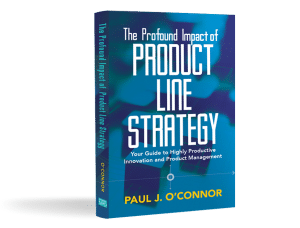Innovation can drive business growth. It’s a key to every organization’s well-being. But many companies carry out innovation haphazardly. They’re more likely to count on serendipity, not strategic thinking, to drive gains from innovation. Unfortunately, management teams have little clarity on why, how, or when to advance product offerings. No wonder Harvard Professor Clayton Christensen calls out a major part of the problem in his book entitled “Competing Against Luck.[i]”
But there’s good news. It’s that product line strategizing and roadmapping – a critical approach to front-end work – is maturing. It’s coming of age. And it’s a meaningful recourse to innovation-by-luck. This is especially true with technology advances like artificial intelligence, 5G, digitalization, and IoT. And luck-based innovation grows more challenging as markets fragment into a growing number of segments.
Uninformed Innovation
Almost every manager knows strategies matter. And they also know about roadmapping. But few managers have the support to conduct these practices superbly and specific to a product line. The result is uninformed innovation. I know the notion of uninformed versus informed innovation sounds simplistic. Yet it’s an important message management teams must hear.
A recent survey entitled the Fourth Product Portfolio Management Benchmark Study[ii] reported interesting results on the topic. It showed how more than half of all managers believe “product portfolios do not align” with a clear strategy. But the survey went further. It shows how managers believe the bad alignment is the root of much pain because it ties to poor decision-making. The dirty little secret is that many management teams “wing it” when it comes to innovation.
This needn’t be the case. Instead, organizations can embrace intelligent product line strategizing and roadmapping. The strategy-roadmap combination is powerful. It ensures innovation is targeting where and how product offerings should take a company. And it works to make companies flexible in how innovations must satisfy customers, drive greater earnings, and fend off competition. It’s about informing innovation work about strategy. And it’s about informing strategy work about possible innovations.
Committing to carry out product line strategizing and roadmapping is a big step for most large companies. It involves cross-organizational work and thinking. It demands building and dissecting insights. And it calls for making deliberate and purposeful decisions. These are tough challenges for companies with established product lines, where culture can push in a different direction.
Innovation and Strategy
The key is to understand product line strategy. This is not just using the word ‘strategic’ in place of the word ‘important.’ It’s about moves and pivots, leverage and advantage, and critical attribute positioning. These then tie to goals and milestones. And it demands flexible and responsive execution.
What sets product line strategizing and roadmapping apart from other approaches is its direct link to business performance. This is because product lines connect customers to the company. If product lines flail, the whole company can go into disarray. And if product lines excel, so too does the organization. Why then do senior managers rely so heavily on serendipity? Do they wish to compete against luck?
No, most top managers don’t want to rely on serendipity, and they don’t want to compete against luck. Truth is, they don’t see it that way. To them, they’re not relying on chance. They believe doubling down on openness to encourage more innovation is the best course forward. They believe the innovation doers will shape the strategy and the means for carrying it out. It’s about nurturing innovation, not managing it.
But nurturing poor strategy moves is not helpful. It takes smart management to keep product line strategies aligned with innovation and the other way around. The issue is not about nurturing; it’s about dampening bad moves and fostering good ones.
Informed Innovation
Product line strategizing and roadmapping helps inform key players give them the right focus and the right insights. I detail this in my book The Profound Impact of Product Line Strategy. In the book, I show how good product line strategies compared with limp strategies can more than double a line’s impact. The key is to understand the characteristics of good product line strategy. And it’s to recognize if the strategy is good or not.
The Profound Impact of Product Line Strategy. In the book, I show how good product line strategies compared with limp strategies can more than double a line’s impact. The key is to understand the characteristics of good product line strategy. And it’s to recognize if the strategy is good or not.
It sounds simple to say informed innovation will outperform an uninformed, serendipity-based approach. But that’s the message. Strong product line strategies and roadmaps drive superior impact from innovations. The onus is on top managers to make sure their product line teams have the wherewithal to form such strategies.
_________
[i] Competing Against Luck: The Story of Innovation and Customer Choice, 2016 HarperCollins Publisher by Clayton M. Christensen, David S. Duncan, Karen Dillon, and Taddy Hall
[ii] Maureen Carlson, 2013 “The Results Are In: Product Leaders Report a Need for Speed and a Roadmap to Sustainable Innovation.”




Leave a Reply
Want to join the discussion?Feel free to contribute!